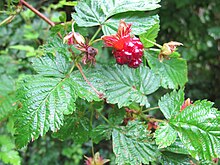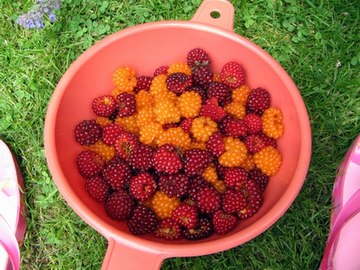|
Rubus spectabilis
Rubus spectabilis, the salmonberry, is a species of bramble in the rose family Rosaceae, native to the west coast of North America from west-central Alaska to California, inland as far as Idaho.[2][3][4] Like many other species in the genus Rubus, the salmonberry plant bears edible fruit, typically yellow-orange or red in color, resembling raspberries in appearance. DescriptionRubus spectabilis is a deciduous, rhizomatous shrub growing to 1–4 metres (3–13 feet) tall and 9 metres (30 feet) wide, with a moderate growth rate of 0.3–0.6 metres (12-24 inches) per year.[5] 30-40% of the plant's biomass is underground.[6] It has perennial (not biennial) woody stems that are covered with fine prickles, especially on new growth.[7] The plant has golden or yellowish brown erect or arching stems (also known as "canes") that often form thickets, like many other brambles in the genus Rubus. The leaves are alternate, trifoliate (with three leaflets), 7–22 centimetres (3–8+1⁄2 inches) long and typically ovate in shape, with the terminal leaflet being larger than the two side leaflets, which are sometimes shallowly lobed. The margins of the leaflets are doubly serrate.[8][9] The leaves are also stipulate and are smooth to slightly hairy on the top surface, compared to the underside, which are typically more pale and hairy.[9] In late fall and winter months, salmonberry leaves will fall, and the plant remains dormant or maintains minimal shoot elongation during the winter.[10] The flowers are 2–3 cm (3⁄4–1+1⁄4 in) in diameter, with a calyx of five hairy sepals and five pinkish-purple petals that surround a cluster of stamens; they are produced between April and July, either singly or in clusters of 2 or 3. The flowers are perfect (bisexual), containing 75–100 stamens and many individual pistils with superior ovaries.[8][9] While fruit production is largely dependent on the environment, there is an estimated growth of 30 fruits per 3m^2 (32 ft^2) and 17-65 seeds per fruit.[11] Salmonberry sprout mainly from the buds found on rhizomes, stumps, and root crowns of the plant. The flowers cannot self-pollinate and are instead pollinated by insects, hummingbirds, and beetles.[10] Salmonberries ripen approximately 30–36 days after pollination, from early May to late July in most of the Pacific Northwest and July to August in cooler Northern climates. They are 1.5–2 cm (1⁄2–3⁄4 in) long and resemble large shiny yellow to orange-red raspberries. The fruit pulls away from its receptacle, differentiating it from blackberries.[citation needed] Botanically speaking, the salmonberry is not a true berry, but instead an aggregate fruit made of many smaller drupelets.[9][12] The fruits of the salmonberry plant exhibit polymorphism, as berries are often either red in color or a yellow-orange color. Studies have found that although both red and yellow-orange morphs have similar physical qualities, the red berries are more commonly consumed by birds, although this is likely not a strong enough selective pressure to determine color morph distribution alone; factors such as soil type (which affects germination), along with other unstudied factors are more likely responsible for the color polymorphism.[13][14][15] A similar species from Japan, the red-flowered raspberry (ベニバナイチゴ) was once considered a subspecies as R. spectabilis subsp. vernus. It is now reclassified as R. vernus.[16]
Distribution and habitatSalmonberries are typically found in coastal areas with nitrogen-rich soils, in moist to wet forests and streambanks, increasing in abundance in areas of high rainfall and decreasing in abundance at higher elevations and continentality. Ecologically speaking, salmonberry tends to spread quickly and needs plenty of room to grow, and is often dominant and fast-growing in early-seral communities. Its size and population growth decline in abundance as the canopy begins to form, and may also be influenced by other factors such as basal area, plant disturbance, and population density.[9][17] In open areas they often form large thickets, and are found to associate with stands of red alder (Alnus rubra), lady fern (Athyrium filixfemina), western skunk cabbage (Lysichiton americanus), devil's club (Oplopanax horridus), thimbleberry (Rubus parviflorus), and threeleaf foamflower (Tiarella trifoliata).[9] EcologyIn the wild, the fruit are typically eaten by birds, bears, and small mammals, among others, while the leaves, twigs, and stems are grazed on by herbivores such as deer, moose, mountain goats, elk, and rabbits.[8][7] Populations of dense thicket growth can provide escape habitats for small animals, as well as nesting sites for birds.[7] In the spring, salmonberry flowering coincides with the migration of certain species of hummingbirds, which is crucial for its pollination.[18] Birds and mammals also help with dispersion of seeds through their feces, while rodents and other burrowing animals may further help with dispersion. Some notable mammals crucial for the dispersion of seeds are the grizzly and American black bears, which can deposit 50,000 to 100,000 seeds in one pile of feces.[14] Salmonberry have several traits that make it highly resistant to fire. Rhizomes and root crowns below the soil surface usually survive, even if top stems are burned. Depending on burial depth, seeds also often remain unharmed. Additionally, the plant tend to quickly sprout after fires, allowing for rapid growth and regeneration.[19] Salmonberries are susceptible to many diseases, including mildew, fruit rot, rust, root rot, and viral and bacterial diseases. Their fruits, foliage, canes, roots, and crowns may also be damaged by pests such as beetles, aphids, mites, moths, among others.[20] UsesSalmonberries are edible.[21][13] The fruit has been referred to as "diverse, from bright, fruity and citrusy to deep and earthy with spicy notes"[22] and depending on ripeness and site, they are good eaten raw – whether red or golden[13] – and when processed into jam, candy, jelly and wine. Native American people ate the young shoots or used it as a medicinal plant. The shoots were harvested during April to early June before they turned woody or tough, and were peeled, then steamed, boiled, or pit-cooked, and eaten (or less commonly, eaten raw).[7][23] Traditionally, the berries and sprouts were also eaten with salmon or mixed with oolichan grease or salmon roe. They were not dried because of their high moisture content.[7][24] It is still used as a food source and medicinal plant in regions of Alaska today. Other uses by Native Americans include:[7]
It is also widely grown as an ornamental plant for its flowers,[13][25][26] with a double-flowered clone identified in Washington and British Columbia.[27] R. spectabilis has escaped cultivation and become naturalized in parts of northwestern Europe, including Great Britain, Ireland and the Faroe Islands.[28][29] CultureThe salmonberry is important to multiple indigenous people of America in its native range. The Makah people call the plant ka'k'we'abupt and the berry ka'k'we; the Cowlitz people call the plant e'twanac and the berry e'twan; speakers of Lower Chinook call it yunts.[30] The Squamish people call the plant yetwánáy and the berries yetwán, the shoots are called stsá7tskaý (pronounced saskay).[31] In the Saanich dialect, it is called elile.[32] The birdsong of the Swainson's thrush, sometimes known as the salmonberry bird, is a phenological indicator known to multiple indigenous people of the Pacific Northwest Coast to be associated with the ripening of salmonberries. The birdsong itself is even said to make the berries ripen,[31] as is the case of the Saanich people who give the birdsong the onomatopoeic translation of "xwexwelexwelexwelexwesh!" meaning "ripen, ripen, ripen, ripen!" This belief is also widespread and is known to the Tlingit, Haida, Haisla, Oweekeno, Kwakwaka'wakw, Nuu-Chah-Nulth, Ditidaht, Sḵwx̱wú7mesh, and the Straits Salish people. The presence of Elasmostethus cruciatus, called the salmonberry bug, is also seen as an indicator to Northwest Coast indigenous peoples that salmonberry shoots are ready to harvest.[33] References
External linksWikimedia Commons has media related to Rubus spectabilis.
|
||||||||||||||||||||||||||||||||||






